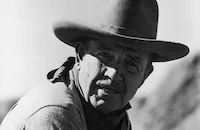The Green Berets

Brief Synopsis
Cast & Crew
John Wayne
John Wayne
David Janssen
Jim Hutton
Aldo Ray
Raymond St. Jacques
Film Details
Technical Specs

Synopsis
Col. Mike Kirby of the U. S. Special Forces takes charge of a strike camp located deep in Viet Cong territory near Da Nang. On hand to report on the unit's action is George Beckworth, a liberal war correspondent whose newspaper has voiced serious misgivings about American intervention in Vietnam. Despite the best efforts of Kirby's men, assisted by South Vietnamese regulars and Montagnard tribesmen, the camp is captured by the enemy. Upon witnessing the torture of a Viet Cong infiltrator during interrogation, Beckworth protests against the Green Berets' tactics, but when he learns of Viet Cong atrocities, he changes his mind about the nature of the conflict and even joins in the fighting. Eventually, Kirby and his men are able to retake the camp after a U. S. Air Force plane has decimated the enemy ranks. Then, aided by Lin, a seductive Vietnamese model whose father was killed by the Viet Cong, Kirby and Vietnamese Colonel Cai capture a high-ranking enemy officer and lead him back to headquarters for questioning. Before the unit returns to the camp, however, Petersen is killed by a booby trap. Kirby must then explain to Hamchunk, a war orphan whom Petersen adopted, that his idol died so the children like him might live.

Cast

John Wayne

David Janssen

Jim Hutton

Aldo Ray
Raymond St. Jacques

Bruce Cabot
George Takei
Luke Askew
Jack Soo
Patrick Wayne
Irene Tsu
Edward Faulkner

Jason Evers
Mike Henry
Craig Jue
Chuck Roberson
Eddy Donno
Rudy Robins
Richard "cactus" Pryor
Bach Yen
Frank Koomen
William Olds
Yodying Apibal
Chuck Bail
Vincent Cadiente
William Shannon
Crew
Jerry Alpert
Newt Arnold
James Lee Barrett
Sass Bedig
William C., (lieut. Col.) Byrns
Joe L. Cramer
Jerold R., (maj.) Dodds
Wayne Fitzgerald
Dave Grayson
Winton C. Hoch
Stanley Jones
Mervyn Leroy
Otho Lovering
Lee Lukather
Cliff Lyons
Ray Moyer
Miklos Rozsa
Capt. August Schomburg Jr.
Walter M. Simonds
Crayton Smith
"red" Turner
Michael Wayne
"hank" Wynands

Photo Collections
Videos
Movie Clip




Hosted Intro
Film Details
Technical Specs

Articles
The Green Berets
Long before box office or critical response became a factor, Wayne had different worries prior to production. He needed some of the resources of the Pentagon to make his film as realistic as possible, but the military brass at the Pentagon were no fans of the 1965 national bestseller on which the movie was based. Robin Moore's collection of short stories called "The Green Berets" portrayed the crack commando unit as lawless, sadistic, and racist. Moore, who plays a cameo in the film and claimed to have trained as a Green Beret, stated that these attributes were the signs of "real men." A feature-length, big budget movie that was to be based on such a depiction of the American military elite made the Pentagon quite nervous. Naturally, Pentagon officials demanded changes to the script before Wayne and company were granted access to Fort Benning, Georgia, with all its modern hardware at their disposal. These conflicts in pre-production, as well as normal shooting delays, hampered the film's release until July, 1968, a full six months after the Communists' Tet Offensive, which was the beginning of the end for an American victory in Vietnam. The delayed release proved unfortunate since The Green Berets arrived on the heels of the notorious My Lai massacre in March, 1968, an incident which seriously undermined the film's credibility.
But for fans of John Wayne, The Green Berets is significant because it is one of his most personal projects and genuinely reflects his true feelings about the Vietnam situation. It also holds the dubious distinction of being the only pro-war film made in the sixties and is justly famous for a hilarious gaffe in the final scene: the film ends with a shot of the sun setting in the China Sea to the east of Vietnam.
Director: Ray Kellogg, John Wayne
Producer: Michael Wayne
Screenplay: James Lee Barrett, based on the novel by Robin Moore
Cinematography: Winton C. Hoch
Editor: Otho Lovering
Music: Miklos Rozsa
Cast: John Wayne (Col. Mike Kirby), David Janssen (George Beckworth), Jim Hutton (Sergeant Petersen), Aldo Ray (Sergeant Muldoon), Raymond St. Jacques (Doc McGee).
C-141m. Close captioning. Descriptive video.
by Scott McGee

The Green Berets
Quotes
What are you going to say in that newspaper of yours about us in Vietnam?- Colonel Mike Kirby
If I say what I feel, I may be out of a job.- George Beckworth
Could you answer a question that all of us are asking?- Reporter
We'll try.- Sergeant Muldoon
Why is America raging this ruthless war in Vietnam?- Reporter
Foreign policy decisions are not made by the military. A soldier goes where he is told to go, and fight whom is told to fight.- Sergeant Muldoon
There is such a thing as due process.- George Beckworth
Out here, due process is a bullet.- Colonel Mike Kirby
Trivia
Much of the film was shot in 1967 at Ft. Benning, Georgia, hence the large pine forests in the background rather than tropical jungle trees.
Some of the "Vietnamese village" sets were so realistic they were left intact, and were later used by the Army for training troops destined for Vietnam.
The colonel who ran the jump school (and who was seen shooting trap with 'Wayne, John' ) was the real jump school commandant and a legendary commander of U.S. paratroopers.
Late in the movie 'Wayne, John' can be seen to wrap his rappelling rope through a carabineer the wrong way. Called a "fatal hookup" in the Army, this would result in an immediate fall once weight was applied.
Co-director Ray Kellogg was originally hired as the second-unit director to stage the various battle and action scenes. During filming, however, 'John Wayne' was so impressed with Kellogg's work that he elevated him to co-director status.
David Janssen was working on this film when the final episode of his series _The Fugitive (1963)_ aired.
Notes
Location scenes filmed in Georgia and Alabama.

Miscellaneous Notes
Released in United States Summer July 1, 1968
Released in United States Summer July 1, 1968














